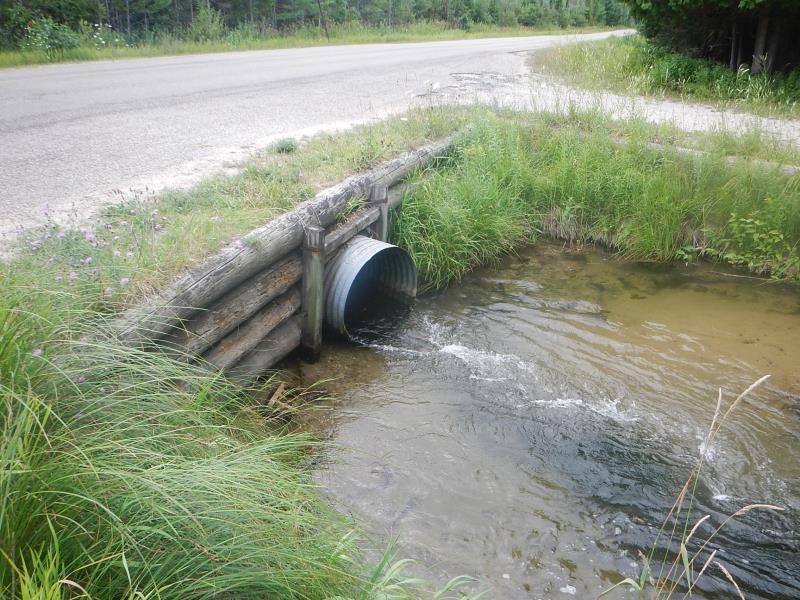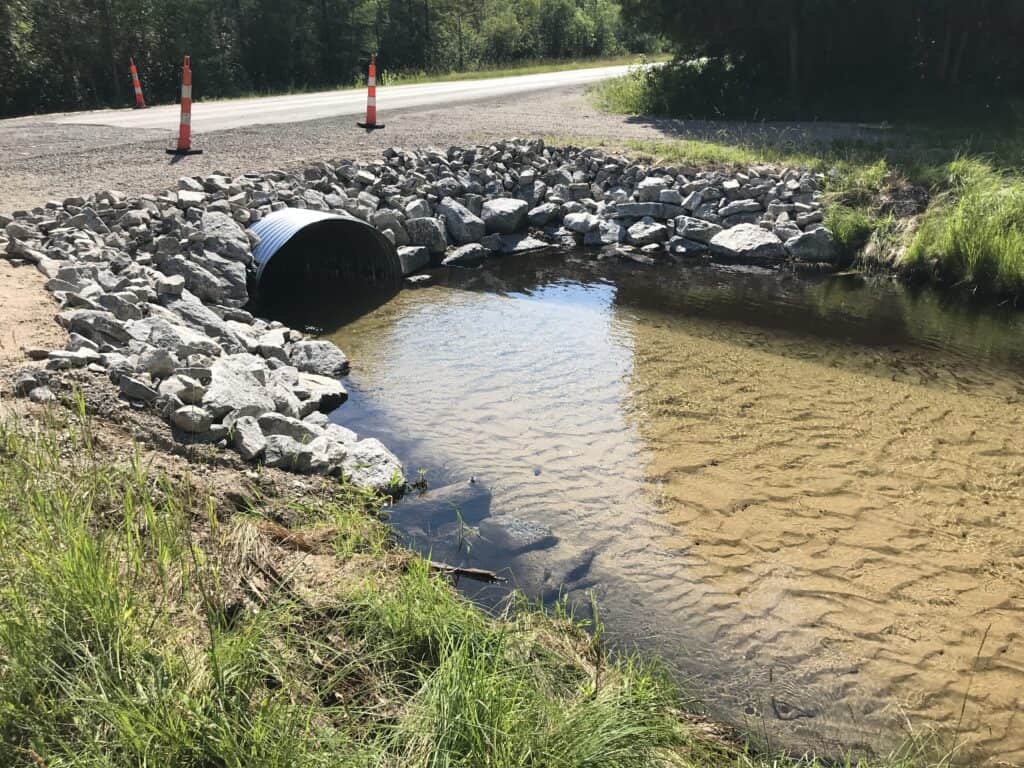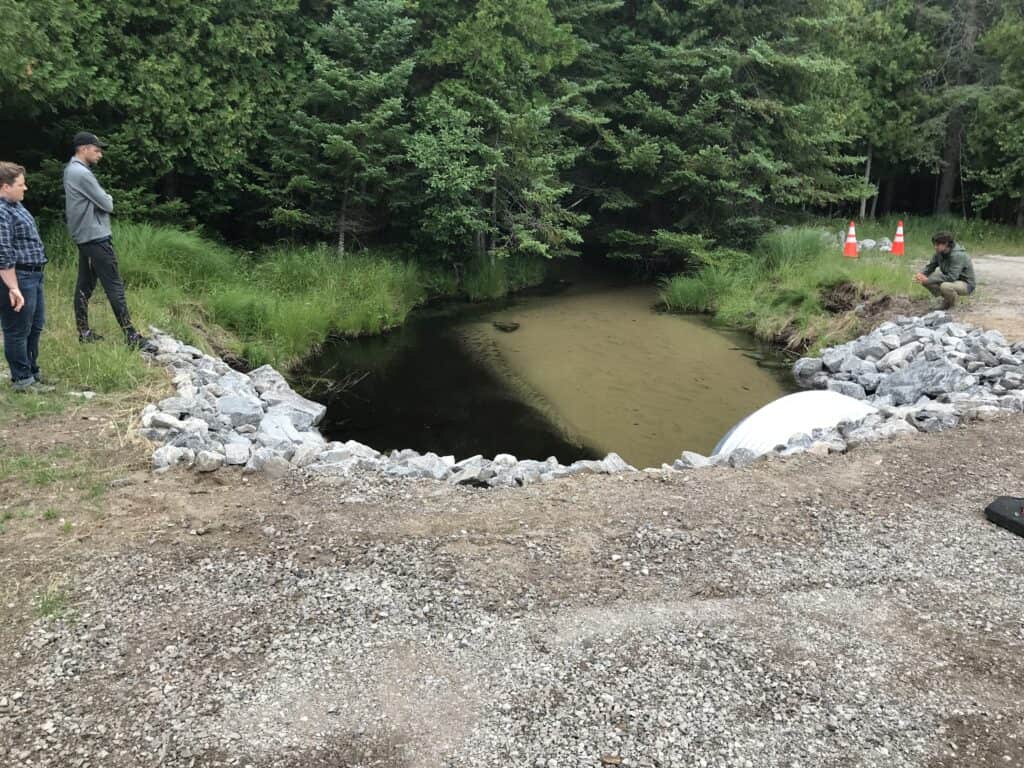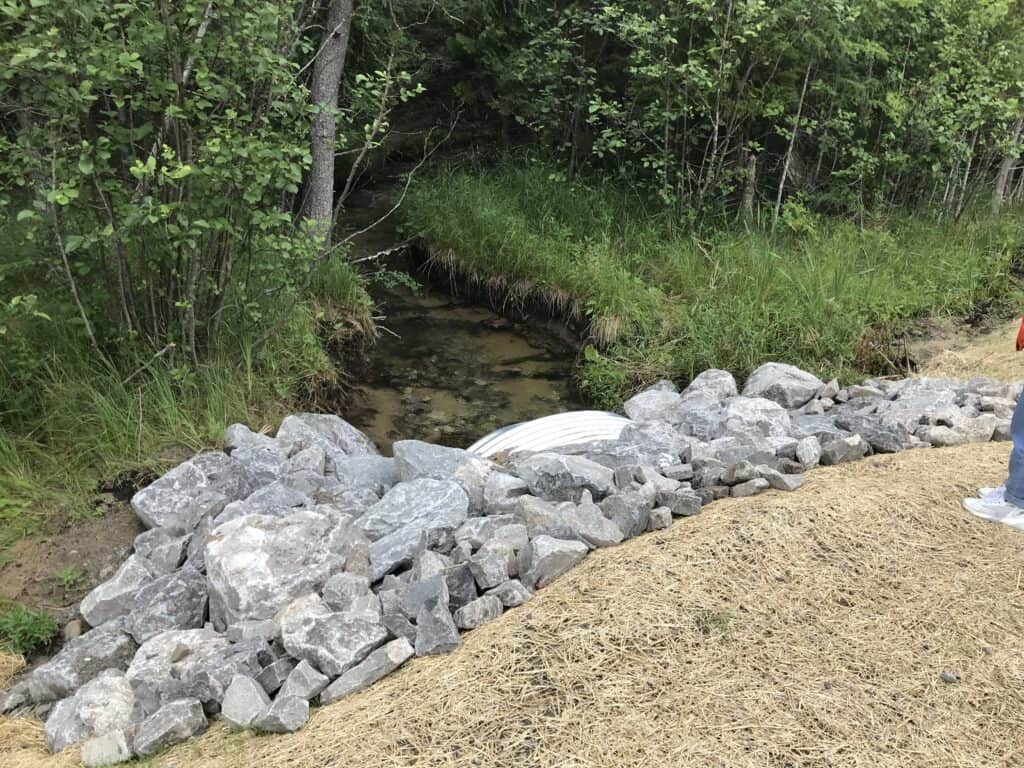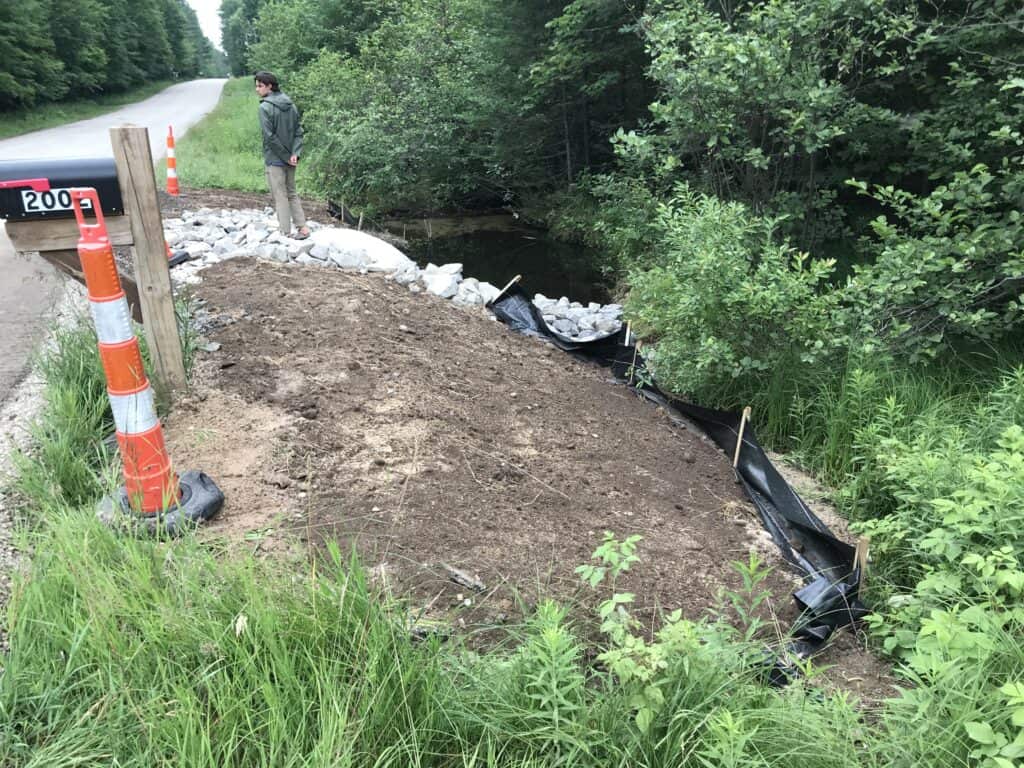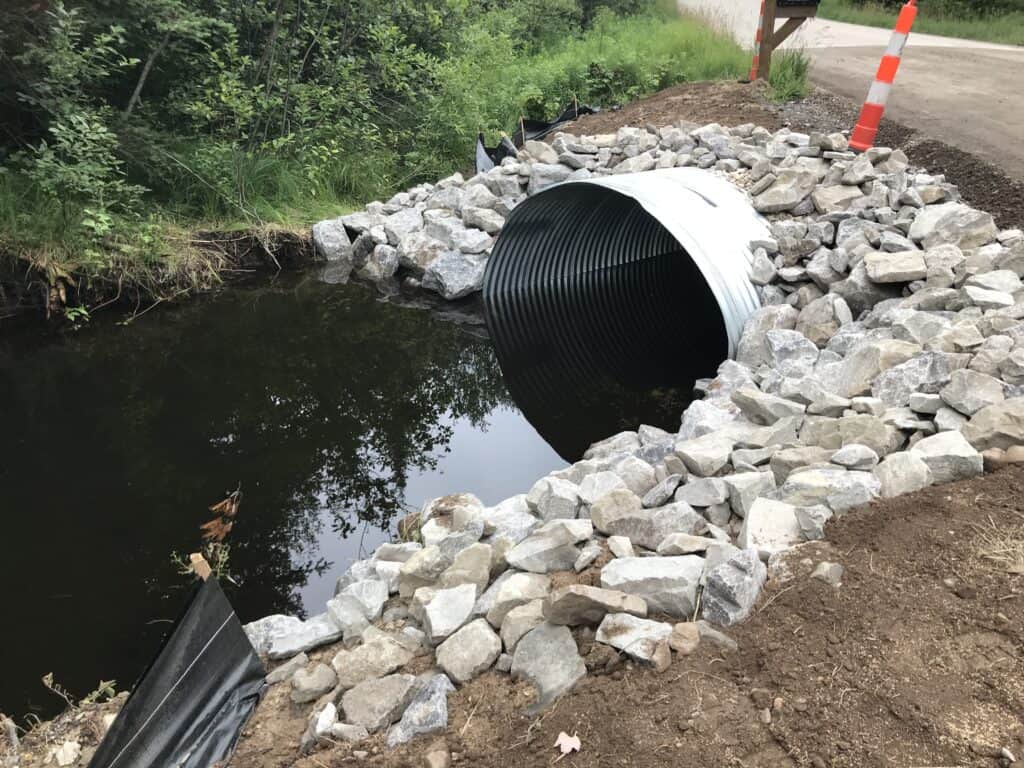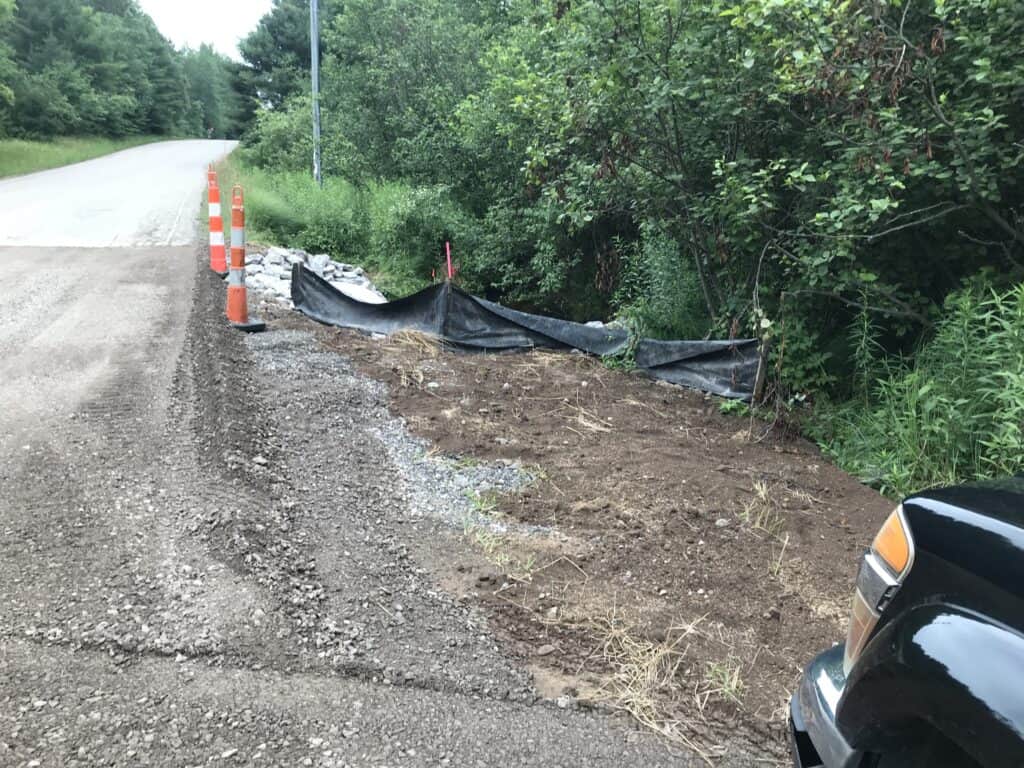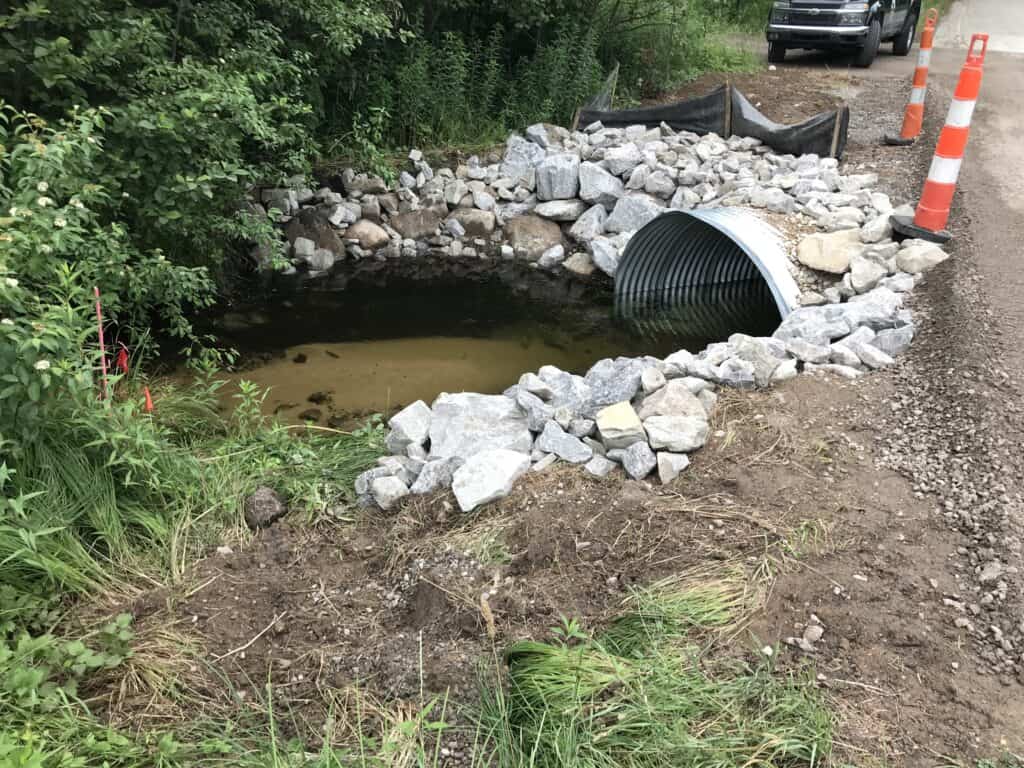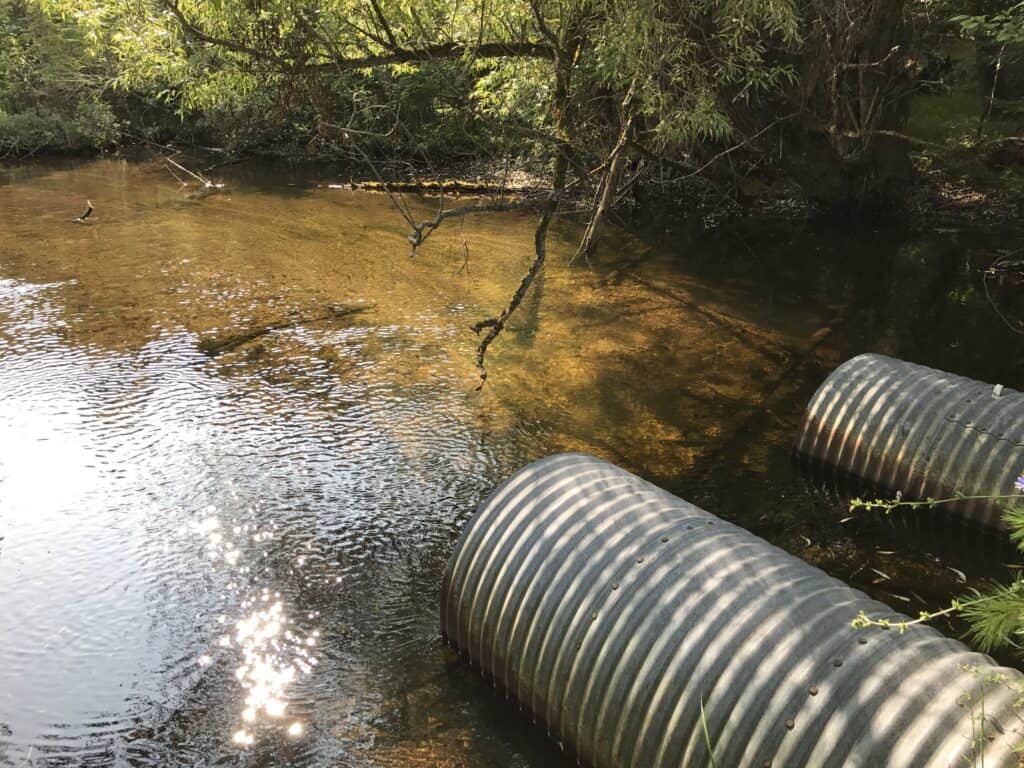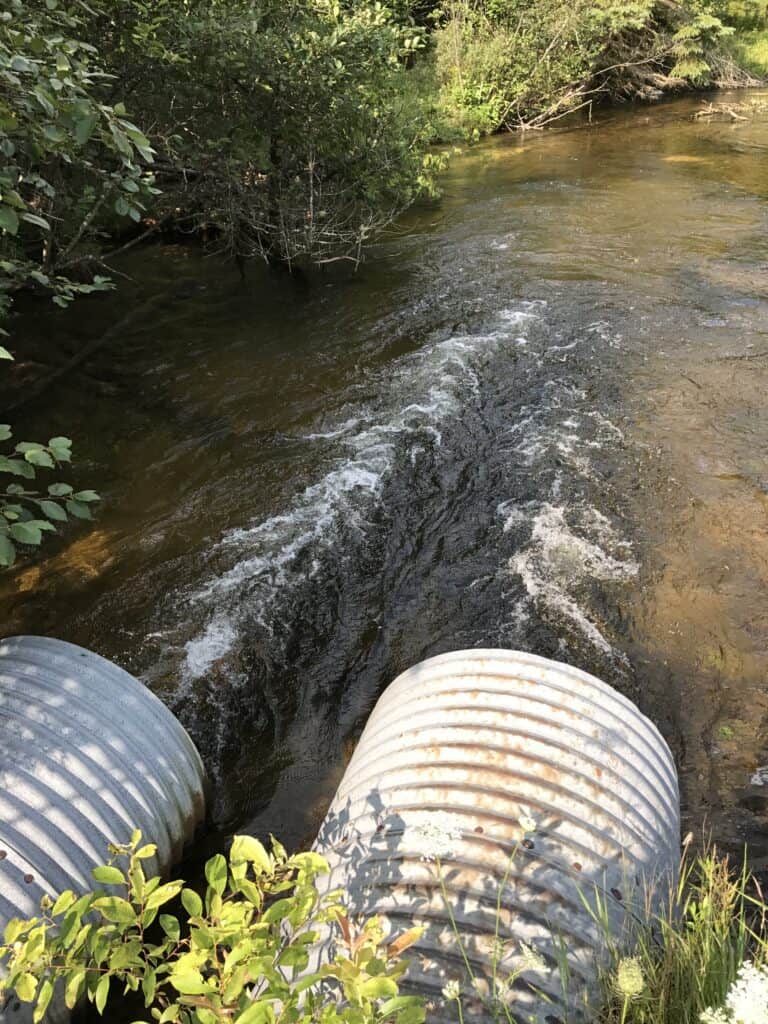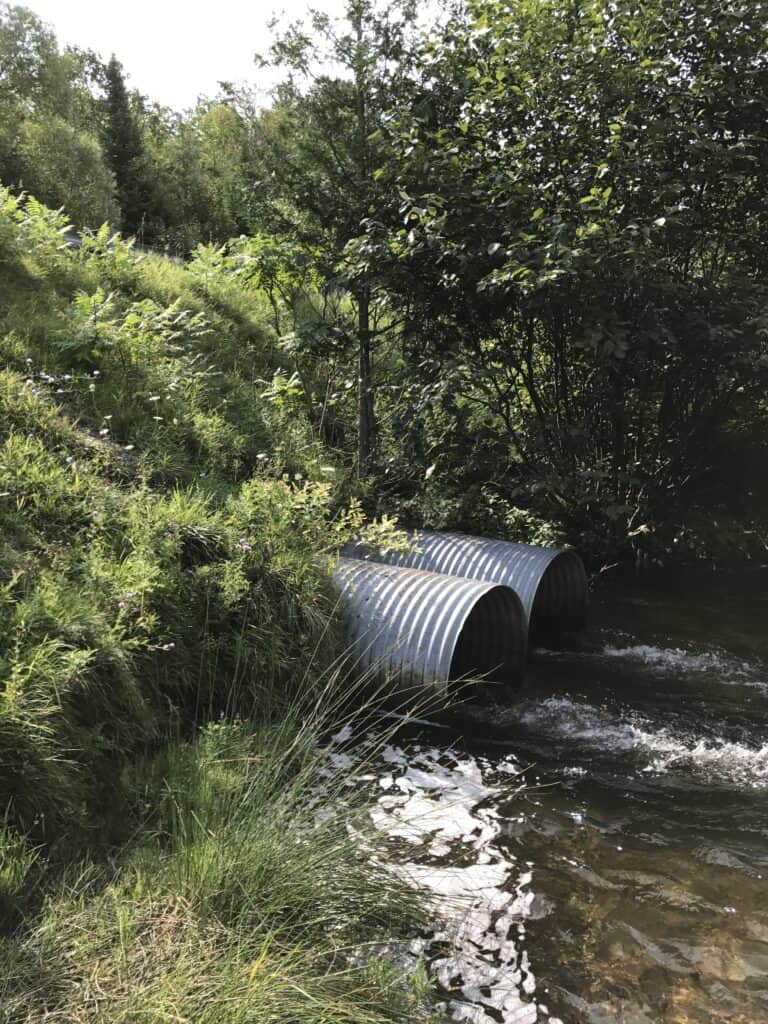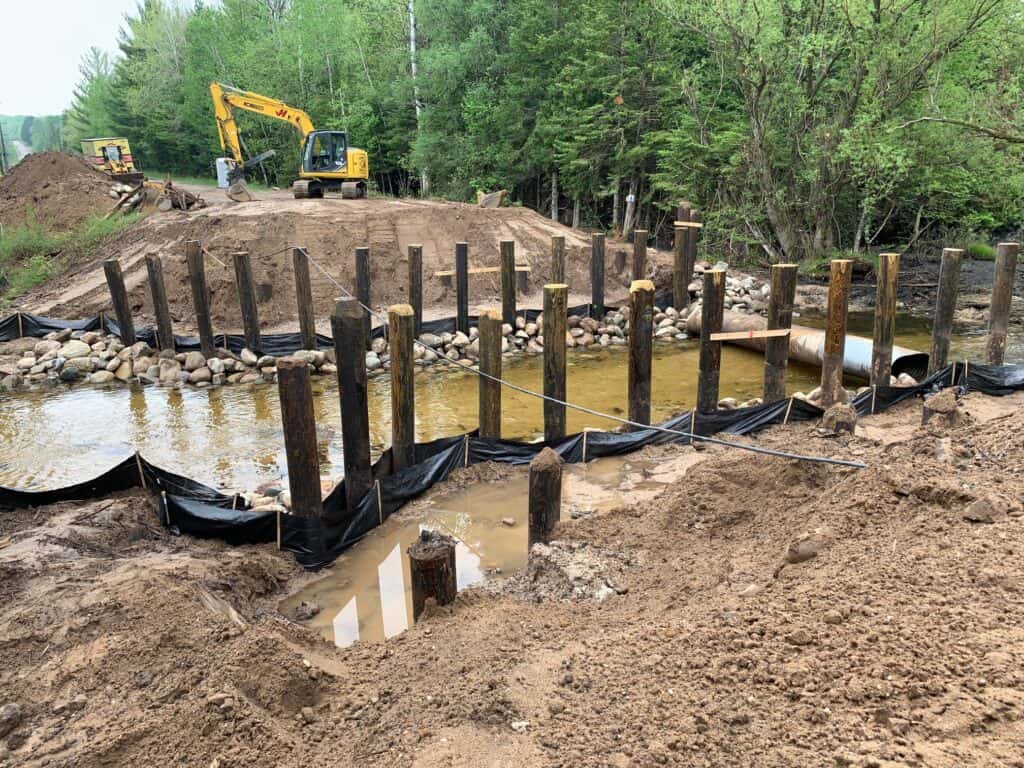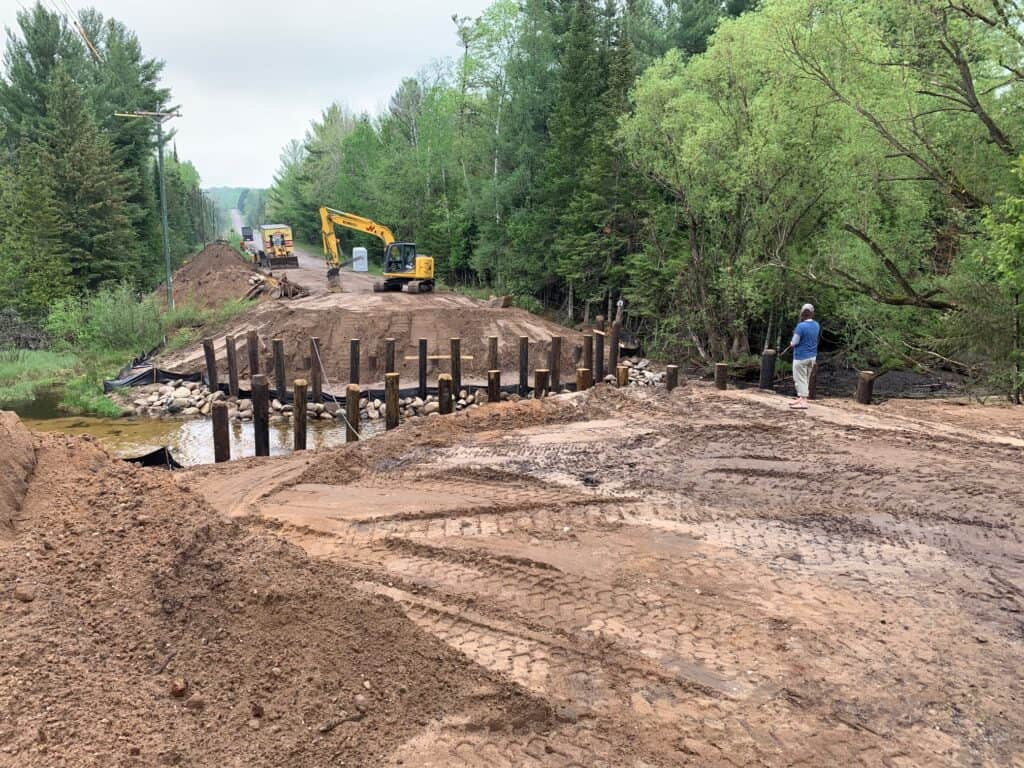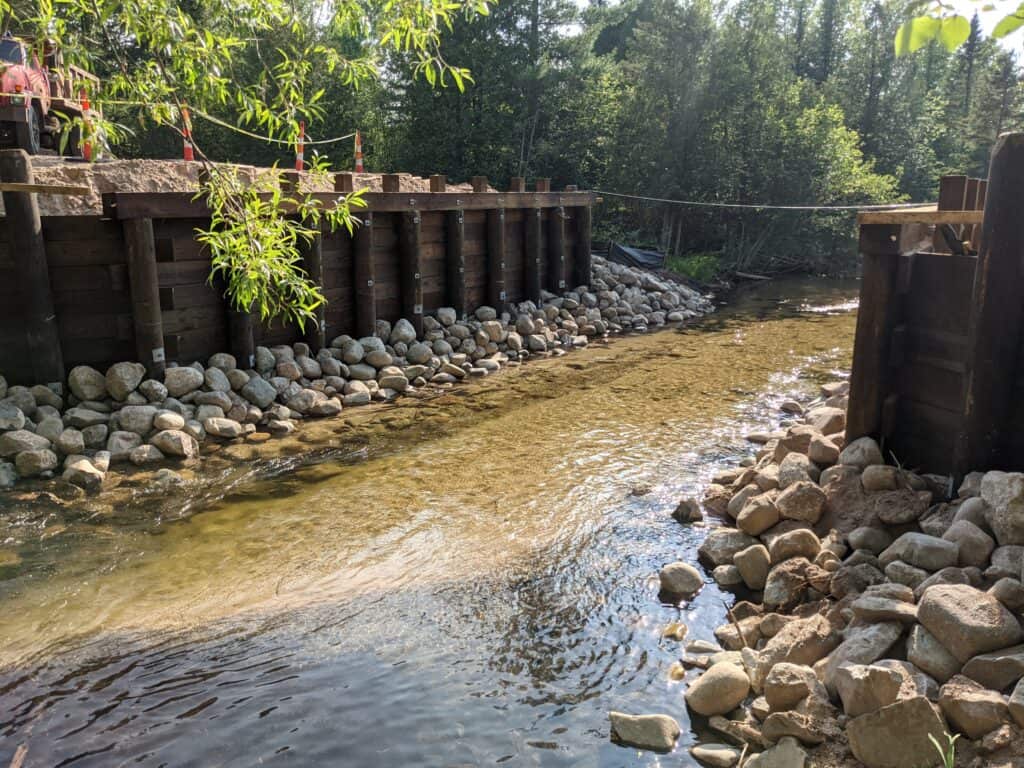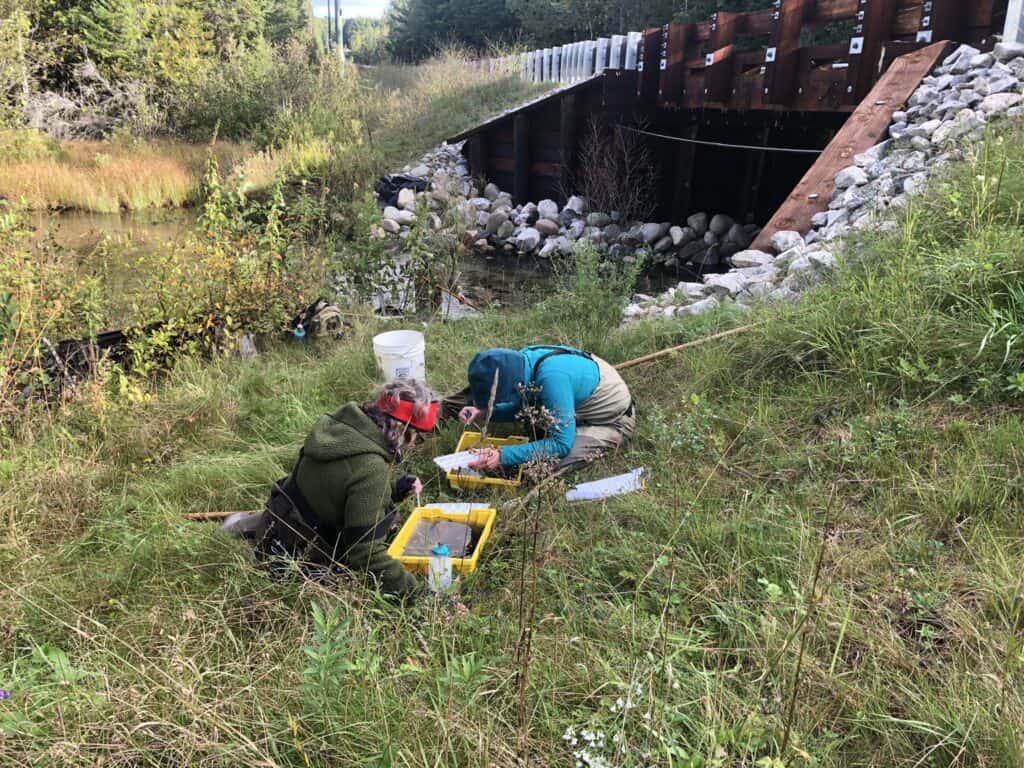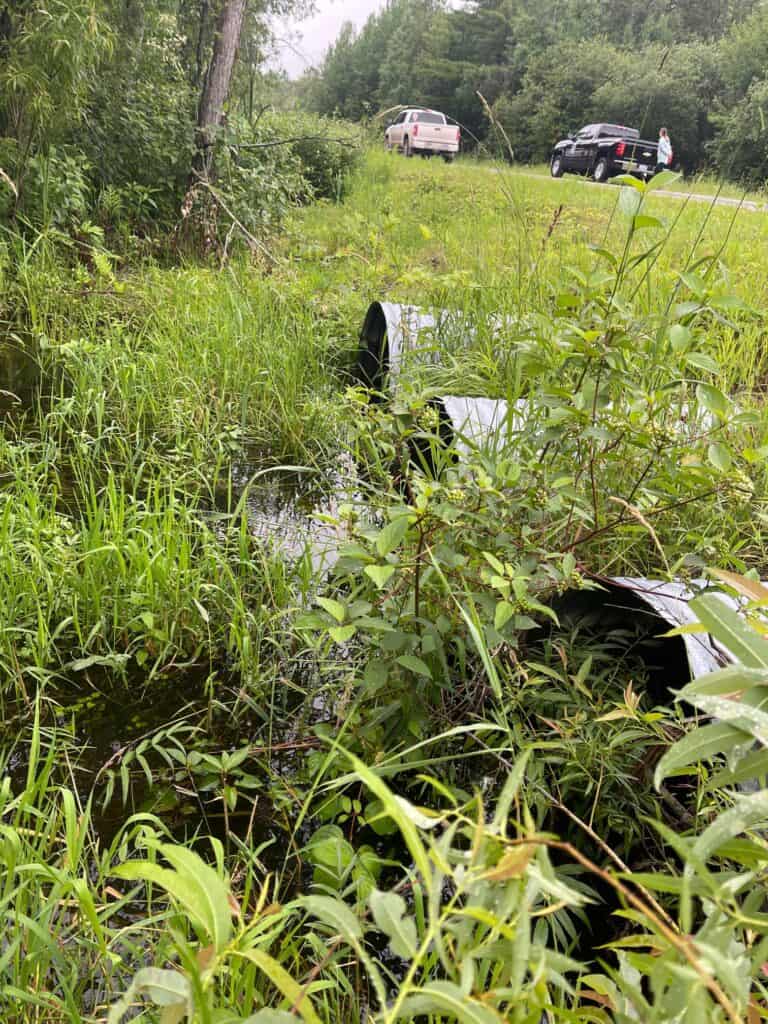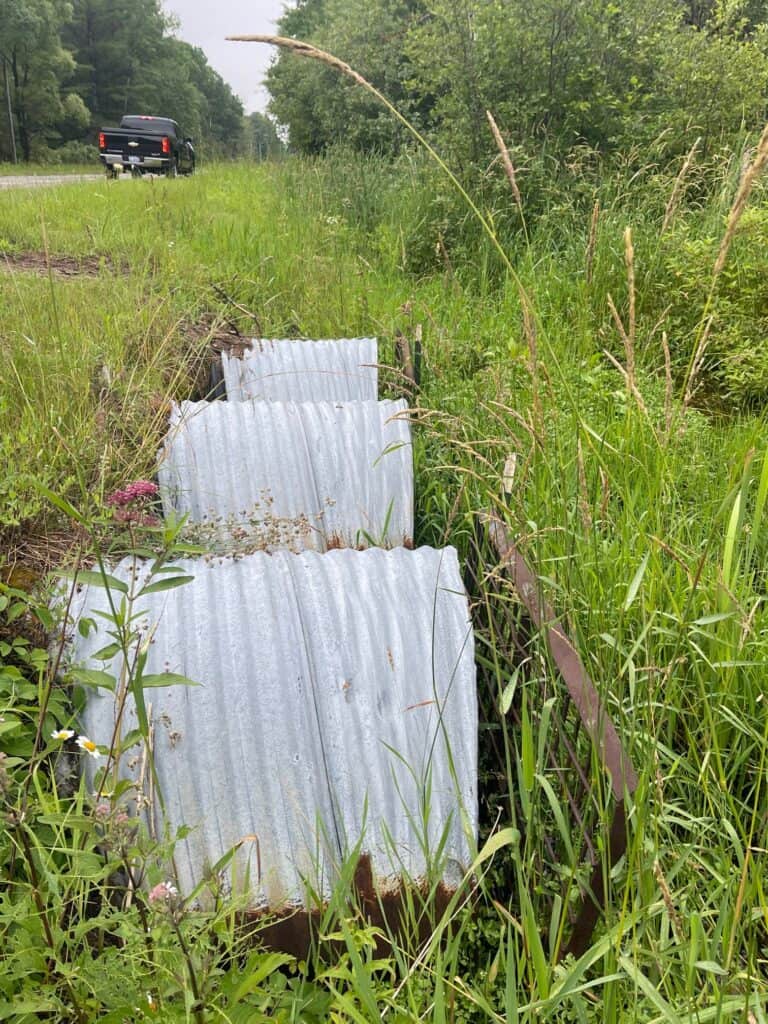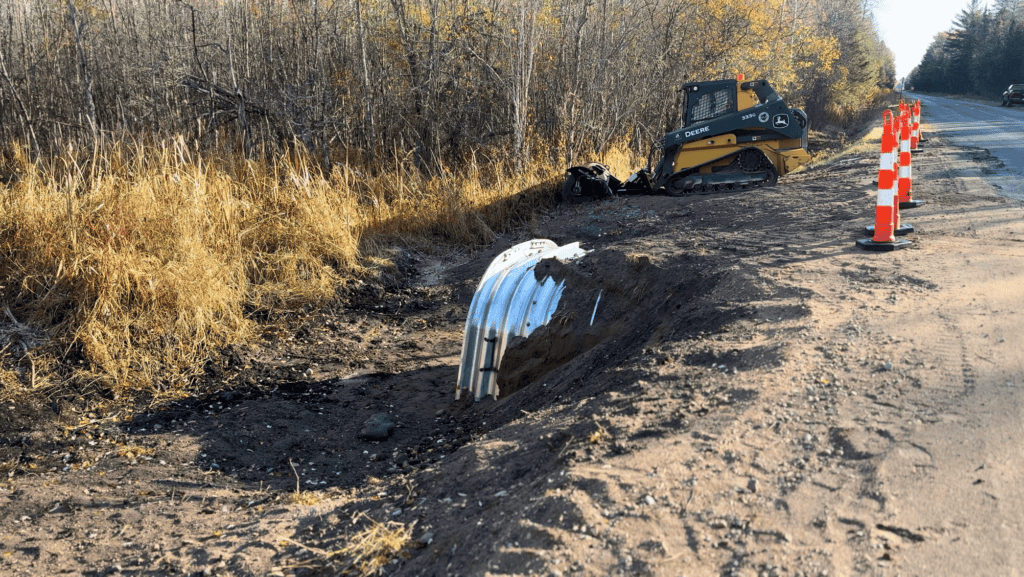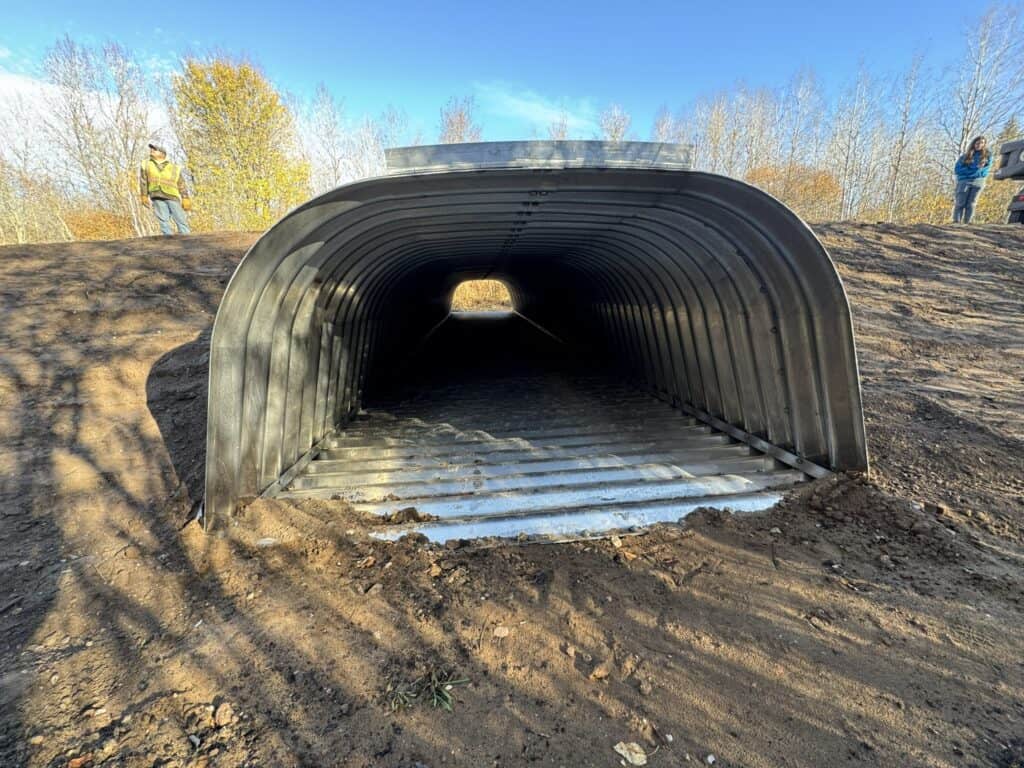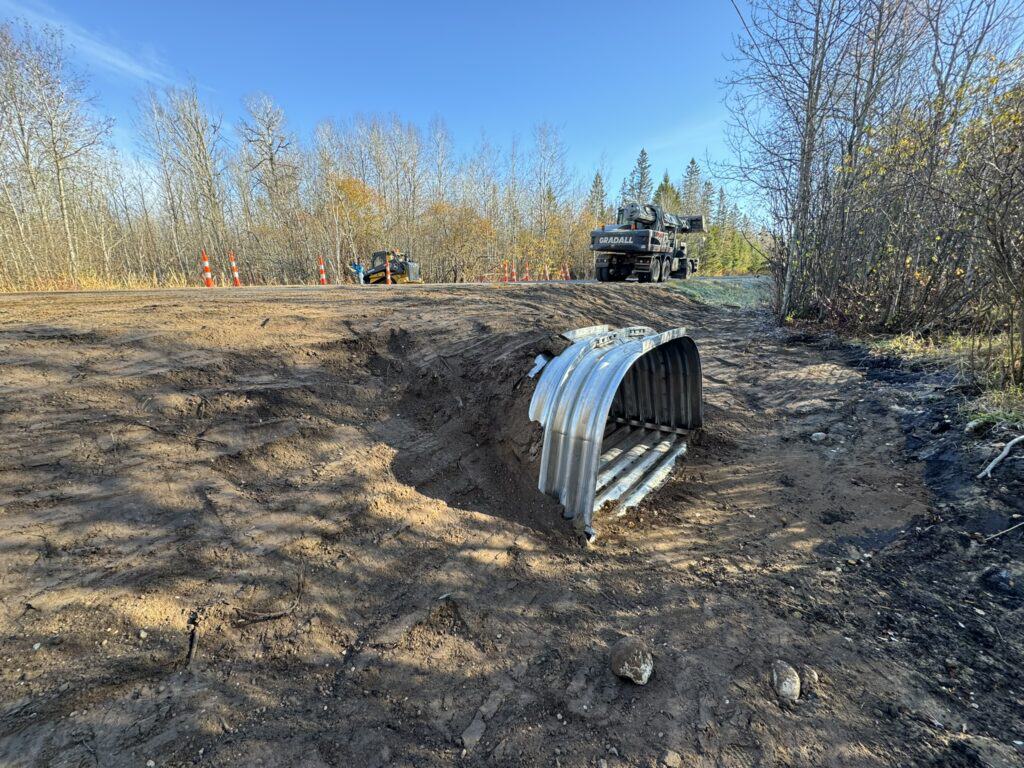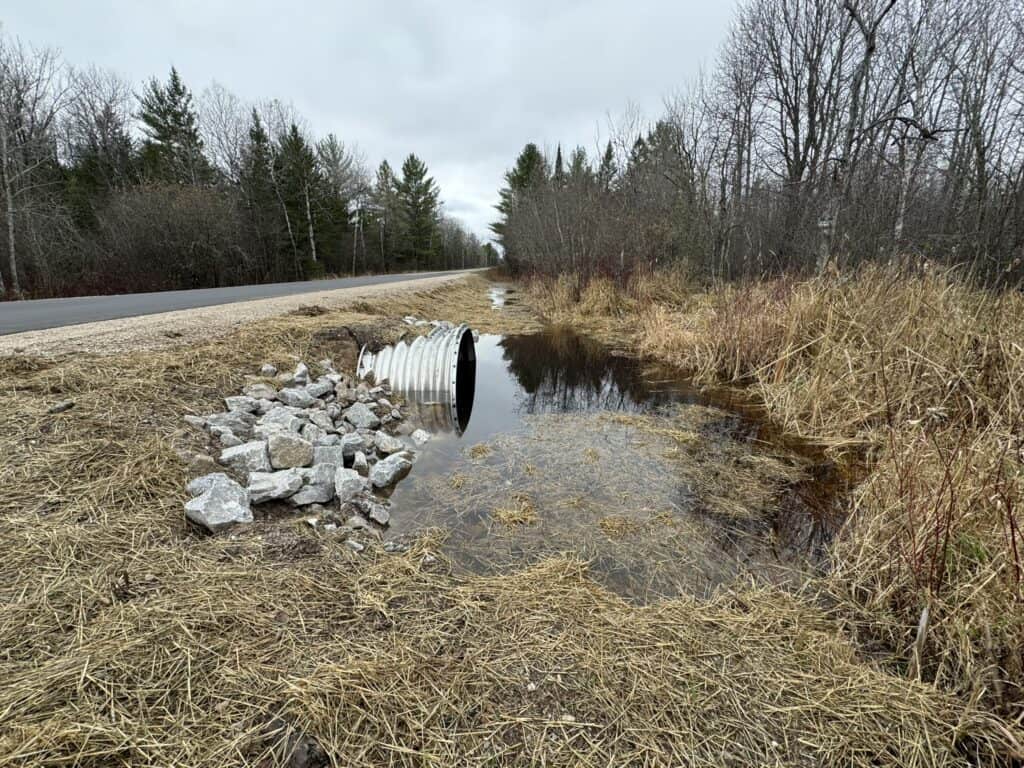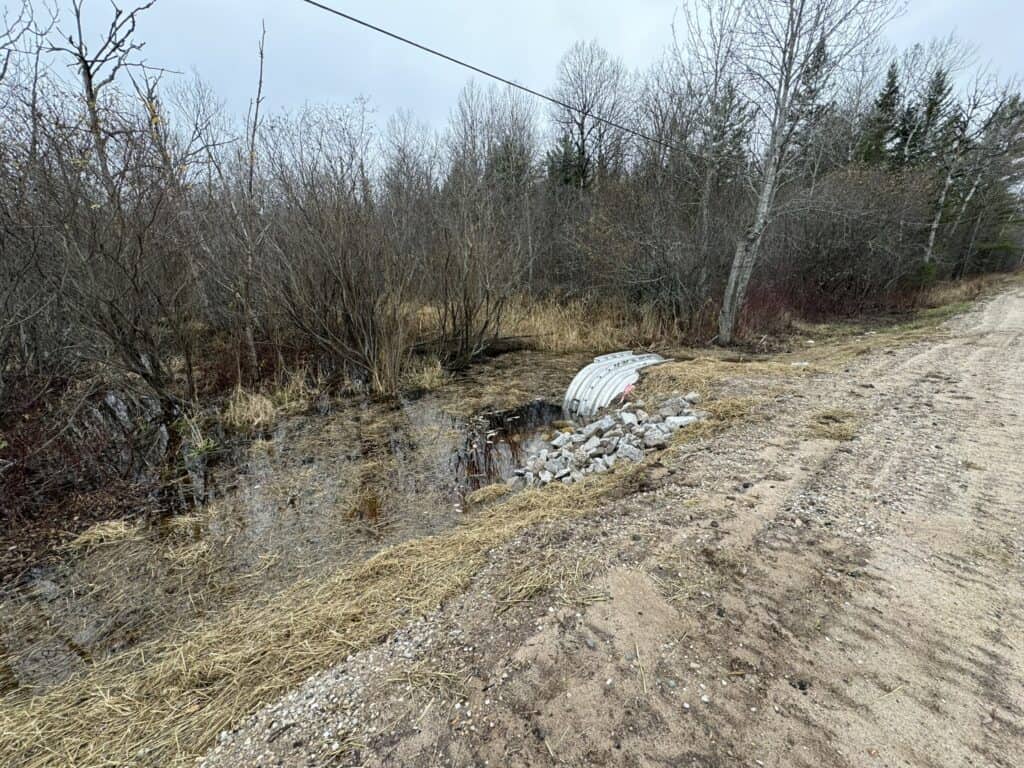Road/Stream Crossing (RSX) Restoration
Road/Stream Crossings (RSX) that are improperly designed or installed, structurally failing, or no longer accommodate current stream conditions affect stream health. They can affect stream hydrology, prevent fish and other aquatic organisms from reaching up-and downstream reaches, increase water temperatures, and are sources of nutrients, sediments, bacteria, heavy metals, and other nonpoint source pollutants. In Northern Michigan, sediments pose the greatest threat to rivers and streams. Sedimentation can adversely impact fish and aquatic organisms by degrading their habitat and reducing water quality.
Road/Stream Crossing Inventories
RSX inventories serve as a useful watershed management tool. They help identify sediment pollution entering surface waters from poorly designed, maintained, or aging stream crossing infrastructure. Inventories also reveal fish passage barriers due to perched culverts, as well as altered stream hydrology from inadequately designed or installed crossings.
After a RSX inventory is completed, the Watershed Council prepares a summary of the inventory results that will highlight the priority sites where attention is needed most due to their current conditions and subsequent threat to water quality. The report also allows us to look for funding to help road commissions offset the cost of RSX improvements.
Follow the links below for an inventory list of each road stream crossing, their condition, and an interactive map that shows you what watershed they are in:
Northern Michigan Streams Website and Interactive Map
https://www.northernmichiganstreams.org/
Great Lakes Stream Crossing Inventory – Information on RSX
https://great-lakes-stream-crossing-inventory-michigan.hub.arcgis.com/
Great Lakes Stream Crossing Inventory – Interactive Map
https://experience.arcgis.com/experience/41a899eeac4e4e84a5b0bd596e2ec16a
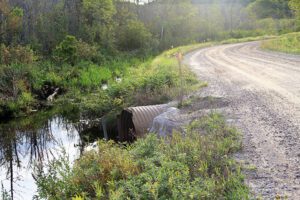
Road/Stream Crossing Projects
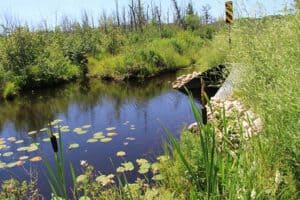
Holms Road Stream Restoration
The Bear River, the largest tributary to Little Traverse Bay, originates at Walloon Lake and flows 12 miles
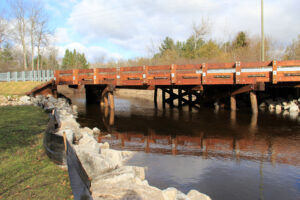
Click Road Stream Crossing
As part of a grant from the Great Lakes Restoration Initiative (GLRI), Tip of the Mitt Watershed Council
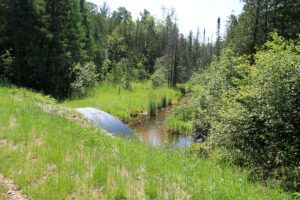
Maxwell Road Stream Crossing
The Maxwell Road Crossing of Minnehaha Creek is part of the Tip of the Mitt Watershed Council’s ongoing
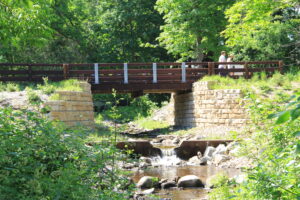
Lower Tannery Creek Stream Bank Restoration Project
The lower section of Tannery Creek was one of the most impaired systems in Northern Michigan. Improvements included
List of Completed Road Stream Crossings
Pickerel Lake Road Stream Crossing Upgrade at Silver Creek 2022
Project Lead: Tip of the Mitt Watershed Council
Road stream crossing replacements were completed at Pickerel Lake Rd. Stream water quality was monitored before and after construction. Silver Creek showed an increase in the number of pollution sensitive taxa after construction. These replacements resulted in improved connectivity of the stream, thereby increasing fish passage, particularly for brook trout.
Project Partners: U.S. Fish and Wildlife Service, National Fish and Wildlife Foundation, Emmet County Road Commission
Project Cost: $150,950
Berger Road Stream Crossing Upgrade at Minnehaha Creek 2022
Project Lead: Tip of the Mitt Watershed Council
Road stream crossing replacements were completed at Berger Road. Stream water quality was monitored before and after construction. Minnehaha Creek maintained its high water quality. These replacements resulted in improved connectivity of the stream, thereby increasing fish passage, particularly for brook trout.
Project Partners: U.S. Fish and Wildlife Service, National Fish and Wildlife Foundation, Emmet County Road Commission
Project Cost: $150,950
Banwell Road Stream Crossing Upgrade at Berry Creek
Project Lead: Tip of the Mitt Watershed Council
The Banwell Road crossing was prioritized over other crossings because the site will potentially yield the greatest benefit to the local brook trout fishery. Removing the barrier increased access to spawning grounds further upstream. According to the prior RSX inventory, the crossing received a “0” fish passage score, which means most species and life stages could not pass at most flows. This project improved stream connectivity in the Crooked River Watershed. The site is still monitored for macroinvertebrate populations annually to track the health of the stream.
Project Partners: U.S. Fish and Wildlife Service, Emmet County Road Commission, Baiardi Foundation, Frey Foundation,
Project Cost: $210,962
Van Creek Road Stream Crossing Updgrade at Van Creek 2024
Project Lead: Tip of the Mitt Watershed Council
Van Creek crossing at Van Road was experiencing plugged culverts causing destabilizing effects on the road shoulder.
Project Partners: National Fish and Wildlife Foundation, Emmet County Road Commission
Project Cost: $75,000
Overview and Process of a Road Stream Crossing
Understanding Road Stream Crossings (RSX): A Comprehensive Overview
Road stream crossings (RSX) are crucial where roads intersect streams or rivers, allowing for transportation without disrupting water flow and ecosystem health. Properly designed RSX benefit communities, infrastructure, and aquatic habitats, while poorly designed crossings can lead to flooding, erosion, and habitat fragmentation. This overview summarizes RSX challenges, solutions, funding processes, and benefits to educate on why these crossings matter.
1. Watersheds and Stream Connectivity
A watershed is an area where all water flows to a shared point, such as a river or lake. Watershed connectivity is essential for allowing water, nutrients, and organisms to move freely, sustaining habitats and water quality. Stream connectivity, however, is often disrupted by poorly designed RSX, which restrict fish passage, impede water flow, and trap sediment. Addressing these issues supports biodiversity, maintains natural sediment transport, and minimizes flooding.
2. The Problems with Outdated RSX Structures
Most RSX structures, like culverts and bridges, were designed with minimal consideration for ecological impact. Common issues include:
- Undersized and Perched Culverts: Culverts that are too small or improperly positioned create “pinch points,” blocking fish passage and causing upstream flooding. Perched culverts, which are elevated above the water flow, require fish to jump, preventing many species from accessing necessary habitats.
- Erosion and Sediment Build-Up: When RSX restrict water flow, pressure builds, leading to bank erosion and sediment accumulation. This sediment can smother spawning grounds and degrade water quality.
- Flooding Risks: Restricted flow can cause water to back up during high rain events, increasing the risk of road washouts and endangering surrounding properties.
3. Funding and Project Implementation
RSX projects often require collaboration among various stakeholders, including road commissions, conservation organizations, and state agencies. Funding is a significant aspect of these projects and can come from a mix of public tax dollars, grants, and partner contributions:
- Securing Funding: Agencies like the Emmett County Road Commission often rely on partnerships with organizations such as the CRA, watershed councils, or tribal entities that lead fundraising efforts. These partners apply for grants or secure contributions from federal or state programs dedicated to environmental restoration and infrastructure resilience.
- Project Coordination: Once funding is secured, coordination begins between partners to plan the project, adhere to environmental regulations, and obtain necessary permits. The process includes public outreach and potential hearings, especially for larger projects impacting over two square miles, to ensure transparency and community input.
- Timing and Planning: The availability of funds can impact when projects start. For instance, Emmett County may need to wait for financial commitments from partners before initiating construction. Once funding and permits are in place, smaller projects can be completed within a few months, while larger ones may require a year or more for thorough planning and execution.
4. Environmental and Community Impacts
Undersized RSX impact both ecosystems and communities. As roadways deteriorate due to erosion or flooding, maintenance costs rise. Moreover, poor crossings disrupt recreational activities like fishing and kayaking, reduce local biodiversity, and can impact the scenic value of watercourses. RSX improvements benefit communities by preserving roads, reducing emergency repair costs, and enhancing access to natural areas.
5. Addressing RSX Challenges
Collaborative efforts between local agencies, conservation organizations, and community members are essential for RSX improvement projects. Conservation organizations work with partners to replace old RSX structures with larger culverts or full-span bridges, which align with natural river beds. These improvements help reconnect habitats and prevent sediment build-up by restoring the natural flow.
6. Benefits of RSX Improvement Projects
Upgrading RSX structures offers numerous long-term benefits:
- Improved Ecosystems: Proper crossings enhance habitat connectivity, supporting fish migration and biodiversity.
- Reduced Erosion and Maintenance: Improved designs reduce erosion, require less maintenance, and lower repair costs. Structures like full-span bridges eliminate pinch points, allowing streams to flow naturally without threatening road stability.
- Community and Recreational Benefits: Effective RSX designs reduce road closures, enhance road safety, and support recreational activities like fishing and paddling by ensuring unobstructed water flow.
Conclusion
Upgrading RSX structures is a vital step in preserving ecological health and community infrastructure. By restoring natural stream connectivity and reducing maintenance costs, communities can protect aquatic ecosystems, enhance local resilience to extreme weather, and create safer, more sustainable roads. Embracing improved RSX designs fosters environmental stewardship and strengthens connections within the community, offering long-term benefits for both people and nature.
The Process of Prioritizing and Replacing Road Stream Crossings (RSX): A Start-to-Finish Guide
Overview
RSX projects often start with the identification of problem crossings, which may result from aging infrastructure, improper design, or environmental concerns.
Step by Step Process of Replacing a Road Stream Crossing
Step 1: Identifying the Need
How RSX Are Chosen for Replacement
- Inventory and Surveys: Organizations like watershed councils, the Department of Natural Resources (DNR), and the Conservation Resource Alliance (CRA) conduct detailed inventories of RSX. Using tools like the Great Lakes Road Stream Crossing Inventory Protocol, they document structural conditions, ecological impacts, and stream connectivity issues.
- Public Input: Local residents and road users often alert road commissions to erosion, flooding, or safety concerns, contributing additional data to prioritize crossings for review.
- Condition Monitoring: Road commissions, such as Emmett County Road Commission, perform regular maintenance inspections and track crossings at risk of failure or those requiring frequent repairs.
Step 2: Prioritizing Crossings for Replacement
How RSX Are Ranked
Crossings are prioritized using a combination of structural, environmental, and community factors:
- Structural Integrity: Crossings at risk of catastrophic failure, such as rotted-out culverts or significant erosion, are prioritized to ensure road safety and access.
- Ecological Impact: Projects that restore stream connectivity, improve fish passage, and reduce sedimentation in critical habitats receive high priority.
- Connectivity and Accessibility: Crossings that improve access to large upstream or downstream habitats are often targeted first to maximize ecological benefits.
- Community and Economic Impact: Crossings that prevent flooding in populated areas or support recreational activities like kayaking and fishing are considered highly valuable.
- Data Tools: Resources such as the Road Stream Crossing Inventory Viewer, managed by DNR and conservation groups, provide data on conditions and allow planners to assess which crossings will provide the greatest overall benefit.
Step 3: Securing Funding
How RSX Projects Are Funded
Funding RSX projects often involves collaboration among multiple stakeholders:
- Grants: Organizations like CRA and watershed councils apply for federal, state, or private grants to cover project costs. Examples include the Great Lakes Restoration Initiative and other conservation-focused funds.
- Tax Dollars: Local road commissions rely on tax revenue for maintenance and smaller-scale RSX projects.
- Partner Contributions: Collaborative funding from entities like the Little Traverse Bay Bands of Odawa Indians or other tribal organizations often supplements large projects.
- In-Kind Contributions: Road commissions contribute labor, equipment, and expertise to reduce overall costs.
Step 4: Permitting
How Permits Are Obtained
Before construction begins, organizations must obtain environmental permits:
- EGLE’s Role: The Michigan Department of Environment, Great Lakes, and Energy (EGLE) oversees permitting for stream crossings, ensuring projects meet ecological and hydrological standards.
- EGLE reviews applications for compliance with state and federal laws, such as the Clean Water Act.
- For larger projects, public hearings may be required to gather community input and assess broader impacts.
- Environmental Assessments: Threatened and endangered species reviews, hydrological studies, and habitat assessments are conducted to minimize environmental disruption during construction.
Step 5: Collaboration and Planning
Roles of Key Organizations
Several groups collaborate to ensure RSX projects are successful:
- CRA: Serves as a project lead, coordinating funding, design, and partner involvement. CRA often identifies crossings in need of replacement and develops plans to address ecological and structural issues.
- DNR: Provides data and expertise on fisheries and stream habitats, helping prioritize projects that enhance aquatic ecosystems.
- Road Commissions: Focus on infrastructure safety and access, contributing technical expertise and labor. They also handle ongoing maintenance and inspect new installations.
- Watershed Councils: Conduct surveys, monitor water quality, and provide valuable data for prioritizing projects.
- EGLE: Oversees permitting and ensures compliance with environmental regulations.
Step 6: Design and Construction
Executing RSX Projects
- Engineering and Design: Collaborating engineers design crossings that align with stream hydrology and bank full width, using culverts, bottomless arches, or full-span bridges as appropriate. Designs prioritize ecological integrity while ensuring structural reliability.
- Construction Timeline: Smaller RSX projects can take weeks to complete, while larger timber bridges or projects requiring significant habitat restoration may span several months. Construction typically occurs in dry seasons (spring through fall) to minimize disruptions.
Step 7: Post-Construction Monitoring
Ensuring Long-Term Success
After construction, organizations monitor RSX performance:
- Road Commissions: Inspect crossings for debris, erosion, and road safety.
- Conservation Groups: Track ecological improvements, such as fish migration and sediment reduction.
- Community Feedback: Continued input from the public helps identify additional maintenance needs or further improvements.
Conclusion
Replacing and prioritizing road stream crossings is a collaborative effort that involves rigorous planning, funding, and environmental stewardship. With partnerships between road commissions, conservation organizations, and regulatory agencies, these projects address structural needs while enhancing ecosystems, supporting recreation, and protecting community resources. This comprehensive approach ensures lasting benefits for both nature and infrastructure.

